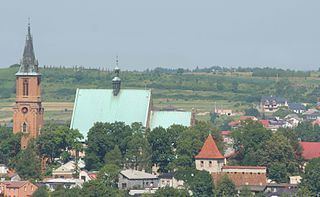Postal code 32-300 - 32-305 Area 25.63 km² Population 36,607 (2014) | County Olkusz County Time zone CET (UTC+1) Car plates KOL Local time Friday 6:37 AM | |
 | ||
Weather 6°C, Wind W at 8 km/h, 93% Humidity Points of interest Muzeum Afrykanistyczne im dr Bo, Muzeum Pożarnictwa Ziemi Olk, Muzeum Twórczości Władysła, Grodzisko Stary Olkusz | ||
Olkusz [ˈɔlkuʂ] (Yiddish: עלקיש Elkish) is a town in south Poland with 36,607 inhabitants (2014). Situated in the Lesser Poland Voivodeship (since 1999), previously in Katowice Voivodeship (1975–1998), it is the capital of Olkusz County. From 1941 to 1945, the occupying Germans renamed the region to Ilkenau. Olkusz is called 'Silver Town" because of the large amount of silver that was found and mined here.
Contents
Map of Olkusz, Poland
Surroundings
The city is on the Baba river, with a major road reaching it from Warsaw and Kraków, making it the central city of the vicinity. Tourists who wish to visit the nature and historical sites, start from here. Also, Olkusz is located on the main railroad line, which connects Upper Silesia and Zaglebie with Kielce.
On the city's website a myth is cited that the city was founded by ancient Phoenicians (Canaanites) who traveled here and found lead ore. The origin of the name Olkusz is cited as the ancient Phoenician (Canaanite Hebrew) "Elkhuds" meaning "to chisel." However, the Hebrew word for "to chisel" was "lakhrot" and the likelihood of the ancient Phoenicians having reached Poland is very low.
A first written historical document from the year 1299 refers to the city of Olkusz, located in the Lesser Poland province of the Kingdom of Poland. The city was initially ruled by citizens of German descent, and the inhabitants were mostly wealthy, due to the lead mines. Silver was discovered too. Various wars crossed the path of this city, which was at its lowest at the end of the 17th century (see: The Deluge).
Jewish Shoah
One of the most famous images of the holocaust is of Rabbi Moshe Hagerman the Dayan - Jewish municipal chief judge, dressed in his Talit and Teffilin and being abused by German soldiers. This image was later identified by people who survived the war and the incident as an image from the 'Bloody Wednesday of Olkusz', taken on July 31, 1940.
Most of the 4097 Jews listed by the Germans were eventually deported to the Auschwitz death camp complex and perished there in the Holocaust. About 250 Jews of Olkusz and its surroundings survived the war.
Religions
Twin towns – Sister cities
Olkusz has a partnership with:
